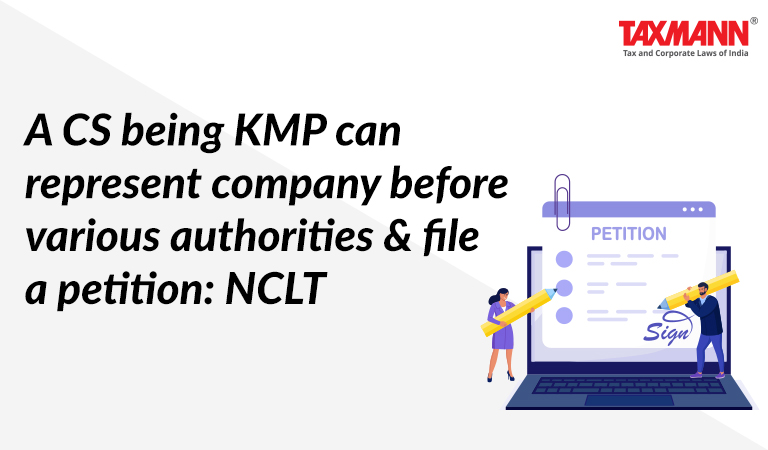A CS being KMP can represent company before various authorities & file a petition: NCLT
- Blog|News|Company Law|
- 3 Min Read
- By Taxmann
- |
- Last Updated on 20 December, 2022

Case Details: Mayank Agarwal v.Technology Frontiers (India) (P.) Ltd. - [2022]145 taxmann.com 305 (NCLT-Chennai)
Judiciary and Counsel Details
-
- S. Ramathilagam, Judicial Member & Anil Kumar B., Technical Member
- P.H. Aravindh Pandian, Sr. Adv. & Edward James, Adv. for the Applicant.
- S. Sriram, PCS for the Respondent.
Facts of the Case
In the instant case, an application was filed before the Adjudicating Authority (NCLT) by the applicant – a director of the company. It was alleged by the applicant that the company alone was empowered to apply u/s 90(7) of the Companies Act, 2013.
As per section 90(7) of the Act
The company shall,—
(a) where that person fails to give the company the information required by the notice within the time specified therein; or
(b) where the information given is not satisfactory,
apply to the Tribunal within a period of fifteen days of the expiry of the period specified in the notice, for an order directing that the shares in question be subject to restrictions with regard to transfer of interest, suspension of all rights attached to the shares and such other matters as may be prescribed.
It was submitted that the company acts through its Board of Directors and that in the present case the Company Secretary had not taken any approval from the Board of Directors to file the said petition.
The applicant further stated that there was no Board resolution nor had any delegated authority to present the petition. Therefore, the petition filed by the Company Secretary pertaining to ensuring compliance with the mandatory requirements in the Companies Act, 2013 under the provisions of section 90 was not valid.
It was further argued that the Company Secretary had no locus standi to file a petition u/s 90 of the Companies Act, 2013. It was propounded that the Company Secretary was not empowered by section 205 or any other provision of the 2013 Act to bypass or supersede the Board of Directors of a company and substitute the authority and powers of the Board of Directors in the Company Secretary’s own wisdom.
The NCLT observed that the Company Secretary is appointed under the Companies Act pursuant to a Board Resolution in respect of which the appointment is given effect by filing the prescribed form with the Registrar of Companies, so as to ensure statutory compliances failing which he is the only officer who receives the show cause notice from the Registrar of Companies so also the Company. He would be required to face the penal consequences in the event of failure of compliance. He is answerable for the violations of the compliance requirement.
NCLT Held
The NCLT held that the Company Secretary is a Watchdog for protecting the Principles of Corporate Governance as well as the collective interest of all stakeholders so also the company. Also, the Company Secretary had the locus standi to file such an application by virtue of the above position of law.
The NCLT, further held that it is fairly clear that the company can be represented by the Company Secretary since he is a key managerial person under section 2(51), officer-in-default as per section 2(60) and as per the power given under section 205(1)(c) read with rule 10 clause 4 of the Companies (Appointment and Remuneration of Managerial Personnel) Rules, 2014.
Thus it is abundantly clear that the Company Secretary can represent before various regulators and other authorities under the Act in connection with the discharge of various duties under the Act. The NCLT being a quasi-judicial authority the Company Secretary can very well do the same.
Accordingly, the Company Secretary in the instant situation had acted diligently and promptly by moving to this Tribunal to ensure compliance with the mandatory provisions u/s 90 of the Companies Act, 2013.
List of Cases Referred to
-
- Nibro Ltd. v. National Insurance Co. Ltd. [1991] 70 Comp. Case 388 (Delhi) (para 9)
- State Bank of Travancore v. Kingston Computers (I) (P.) Ltd. [2011] 11 taxmann.com 172/102 CLA 124/107 SCL 377/2 Comp. LJ 473/163 Comp. Case 37/[2011] 11 SCC 524 (SC) (para 9)
- United Bank of India v. Naresh Kumar [OA No. 463 of 2014, dated 23-10-2015] (para 13).
Disclaimer: The content/information published on the website is only for general information of the user and shall not be construed as legal advice. While the Taxmann has exercised reasonable efforts to ensure the veracity of information/content published, Taxmann shall be under no liability in any manner whatsoever for incorrect information, if any.

Taxmann Publications has a dedicated in-house Research & Editorial Team. This team consists of a team of Chartered Accountants, Company Secretaries, and Lawyers. This team works under the guidance and supervision of editor-in-chief Mr Rakesh Bhargava.
The Research and Editorial Team is responsible for developing reliable and accurate content for the readers. The team follows the six-sigma approach to achieve the benchmark of zero error in its publications and research platforms. The team ensures that the following publication guidelines are thoroughly followed while developing the content:
- The statutory material is obtained only from the authorized and reliable sources
- All the latest developments in the judicial and legislative fields are covered
- Prepare the analytical write-ups on current, controversial, and important issues to help the readers to understand the concept and its implications
- Every content published by Taxmann is complete, accurate and lucid
- All evidence-based statements are supported with proper reference to Section, Circular No., Notification No. or citations
- The golden rules of grammar, style and consistency are thoroughly followed
- Font and size that’s easy to read and remain consistent across all imprint and digital publications are applied





